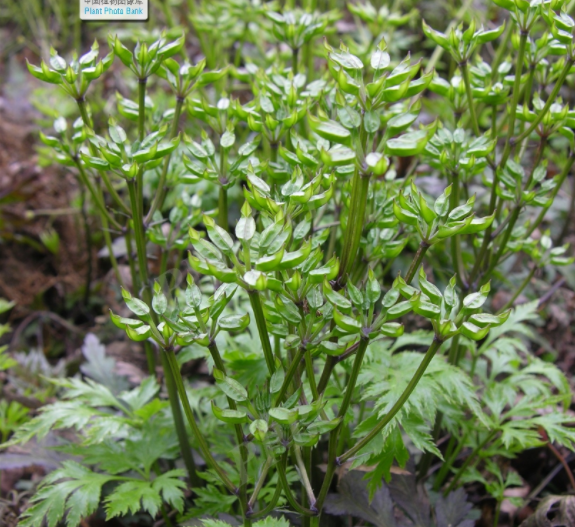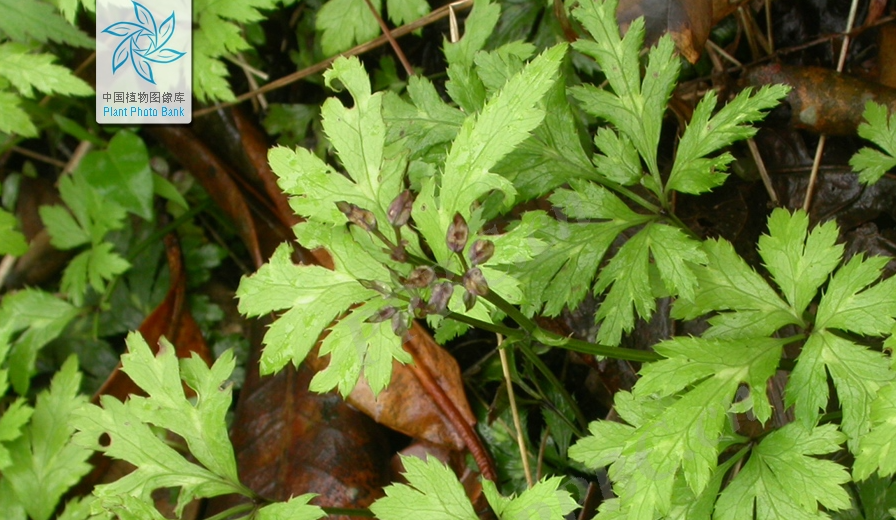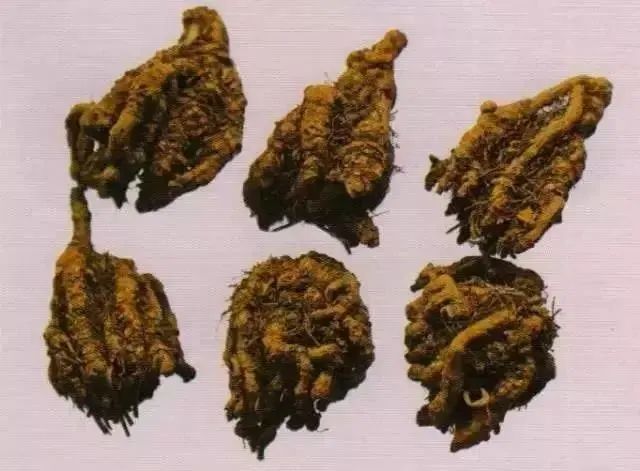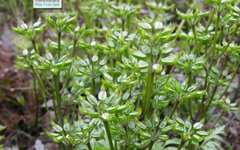Introduction to the Species
This species is a plant of the Ranunculaceae family, known as Huang Lian Coptis chinensis Franch.
1
Morphological Characteristics
Perennial herb. The rhizome is yellow, often branched, densely covered with numerous fibrous roots. The leaves are all basal; petiole length is 5–12 (up to 16) cm; leaf blade is thick and papery, ovate-triangular, up to 10 cm wide, and 3-lobed; the central lobe has a short petiole, is ovate-rhombic, 3–8 cm long, 2–4 cm wide, with a sharp apex, deeply pinnately lobed, and serrated edges, while the lateral lobes are unevenly deeply lobed, with the surface along the veins covered in short soft hairs. The flower stalk is 1–2, 12–25 cm high, with a dichotomous or multi-branched umbel, having 3–5 flowers; the involucral bracts are usually 3, lanceolate, deeply lobed, and the smaller bracts are round and slightly smaller; there are 5 sepals, yellow-green, narrowly ovate, 9–12.5 mm long; the petals are linear or linear-lanceolate, 5–7 mm long, with a nectar groove in the center; there are numerous stamens, with the outer whorl of stamens slightly shorter or nearly equal in length to the petals; there are 8–12 carpels, free, with short stalks. The capsule contains 6–12 fruits, 6–8 mm long, with fine stalks. The flowering period is from February to April, and the fruiting period is from March to June.


Figure. Coptis chinensis
2
Habitat Distribution
Prefers cool, shady, and moist environments, growing in dense forests at altitudes of 1000–2000 m or in cool valleys. It can be found wild or cultivated. It is distributed in Shaanxi, Hubei, Hunan, Sichuan, Guizhou, and other regions.
3
Harvesting Characteristics
[Huang Lian]
This product often clusters together, commonly bent, resembling a chicken’s foot, with a single stem rhizome length of 3–6 cm and a diameter of 0.3–0.8 cm. The surface is grayish-yellow or yellow-brown, rough, with irregular nodular protrusions, fibrous roots, and remnants of fibrous roots; some internodes have a smooth surface like a stem, commonly referred to as “crossing the bridge.” The upper part often retains brown scale leaves, and the apex usually has remnants of the stem or petiole. It is hard, with an uneven cross-section, the bark is orange-red or dark brown, and the wood is bright yellow or orange-yellow, arranged radially, with some hollow pith. The aroma is faint, and the taste is extremely bitter.
Harvesting: Harvest in autumn, remove fibrous roots and soil, dry, and knock off remaining fibrous roots.
Processing: [Huang Lian slices] remove impurities, soak until soft, then slice thinly and dry, or crush when needed. [Wine Huang Lian] take clean Huang Lian, and fry it with wine (as per method 0213) until dry. For every 100 kg of Huang Lian, use 12.5 kg of yellow wine. [Ginger Huang Lian] take clean Huang Lian, and fry it with ginger juice (as per method 0213) until dry. For every 100 kg of Huang Lian, use 12.5 kg of fresh ginger. [Evodia Huang Lian] take Wu Zhu Yu and boil with an appropriate amount of water, mix the decoction with clean Huang Lian, and dry after the liquid is absorbed. For every 100 kg of Huang Lian, use 10 kg of Wu Zhu Yu.

Figure. Huang Lian
4
Functions and Indications
[Huang Lian]
Bitter, cold. It enters the Heart, Spleen, Stomach, Liver, Gallbladder, and Large Intestine meridians. It clears heat and dries dampness, drains fire and detoxifies. It is used for damp-heat obstruction, vomiting with sour regurgitation, diarrhea, jaundice, high fever with delirium, excessive heart fire, irritability and insomnia, palpitations, blood heat with vomiting or nosebleeds, red eyes, toothache, diabetes, and carbuncles; externally used for eczema, damp sores, and purulent ear discharge.
Wine Huang Lian is effective in clearing heat from the upper jiao. It is used for red eyes and oral ulcers.
Ginger Huang Lian harmonizes the stomach and stops vomiting. It is used for cold-heat counterflow, damp-heat obstruction, and fullness with vomiting.
Evodia Huang Lian soothes the liver and harmonizes the stomach to stop vomiting. It is used for disharmony between the liver and stomach, with vomiting and sour regurgitation.
Disclaimer:This article is excerpted from “Flora of China”, 5th edition “Medicinal Botany”, and 2020 edition “Chinese Pharmacopoeia”, published by the Chinese Herbal Resource Monitoring and Service Platform. If the author or editor believes that their work should not be published on the WeChat platform or should not be used without compensation, and feels that your rights have been infringed, please contact us: [email protected], Chinese Herbal Resource Dynamic Monitoring System (http://zyzyjc.zyzypc.com.cn/).
[Chief Editor] Li Jun De [Editing and Compilation] Ye Yang Yu Zhang Tian

↓↓↓ Click “Read the original text” to view historical messages

